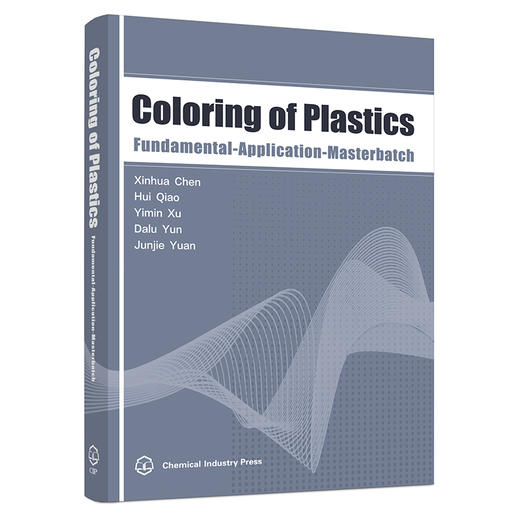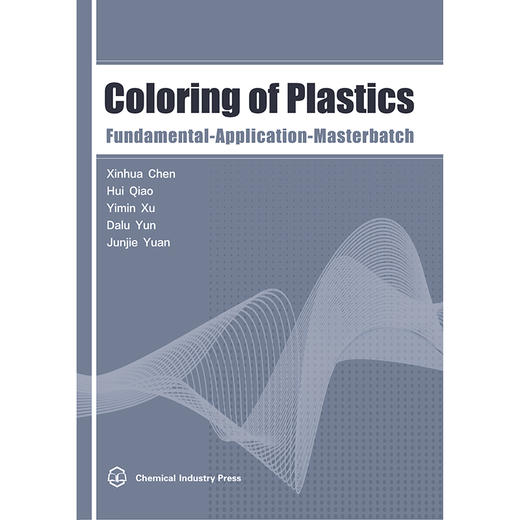Coloring of Plastics——Fundamental-Application-Masterbatch
| 运费: | ¥ 0.00-20.00 |
商品详情
| 书 名: Coloring of Plastics——Fundamental-Application-Masterbatch |
| 作 者: Xinhua Chen、Hui Qiao、Yimin Xu、Dalu Yun、Junjie Yuan 编著 |
| I S B N: 26506 |
| 完整书号: 978-7-122-26506-7 |
| 出版年份: 2016 |
| 出版月份: 06 |
| 版 / 印次: 1-1 |
| 定 价: 98.00 |
| 开 本: 16 |
编辑推荐:
本书对与着色剂相关的知识进行了系统介绍。在介绍各种颜料、染料品种、性能基础上,还对着色剂的检验、在塑料中的分散,塑料配色技术、着色成型工艺以及相关的国际、国内法规体系及相关标准进行了介绍。主要作为沟通着色剂使用者和生产者的桥梁,以便以较低的成本实现较大的着色效果。
内容简介:
本书对与塑料着色相关的知识进行了系统的总结。在对塑料着色剂的性能要求进行初步介绍的基础上,首先对无机颜料、效果颜料、有机颜料、溶剂染料的品种、性能及应用进行了重点论述,然后介绍了着色剂的检验方法和标准、颜料在塑料中的分散、塑料配色实用技术与质量控制、塑料着色成型工艺、塑料着色国际法规体系及相应的要求等。
本书希望能够成为沟通着色剂使用者和生产者的桥梁,成为塑料着色入门者以及着色剂研发、生产、销售和应用人员的工具书。
序言:
Masterbatch industry in China, along with development of the rests of plastics
industry, has experienced a historical growth: from non-exiting to its nascent
appearance, from a feeble status in the past to a strong identity today. The
author has accumulated invaluable experience in plastic coloring from 40 years
of theoretical research and experimental activities. Thanks for publication of
this book, every reader can share and benefit from such experience. As referred
by the author, plastics coloring is a systematic project. It has a huge and
complex industrial connection, which requires employees to have knowledge
regarding color, materials, mechanical engineering, legal concerns, regulatory
requirements and so on. This book offers a systematic introduction of the
masterbatch industry and related knowledge. It was written to be professional,
informative and comprehensive to its readers. It is an instrumental reference
book in plastic coloring.
I first got to know the wonderful world of
masterbatch in 1982 and witnessed the development of Chinese masterbatch
industry. Such industry in China started from the seventies of last century.
After nearly 40 years of development, the annual output has reached more than 1
million tons. Now it has become an indispensable strategic partner of plastics
and chemical fiber industry, and ubiquitous worldwide. Taking advantage of
publishing English version of this book, I wish to bridge Chinese masterbatch
industry and those around the world. Together, we can communicate, develop and
make the world to radiate her best ever beauty !
Hui Qiao
February
2016
前言:
Plastics has merged into our daily lives everywhere. We enjoy benefits of these
products all the time. A list of examples includes children’s toys, instrument
components, computer housings, automotive parts, toothbrush, tooth-cylinder,
hygiene products, aircraft parts, aerospace applications and so on. It is a
miracle that the plastics products has advanced to such level of industrial
success in just 100 years, and continues to grow at an incredible
rate.
Plastic coloring industry chain is composed of 3 key sectors: pigment
and dye manufacturing, masterbatch and modified plastics manufacturing, and
plastics processing. Masterbatch and modified plastics manufacturing industry is
a connecting link of upper stream and downstream industries. Therefore it plays
an important role to the whole plastic coloring industry chain. The historical
experience shows that masterbatch and plastic processors do not have good
understanding of complexity of colorants. On the other hand, pigment and dye
manufacturers have limited understanding of plastics and plastics processing.
Therefore, a sufficient information exchange between industrial chains is very
important. It can significantly enhance mutual understanding between upper and
down-stream industries to achieve higher standards of product quality.
For
colorants users, the value of colorants depends on color appearance, color
retention and its processing performance. If a colorant has high-value of color
performance but poor processing performance, the value of application will be
lower. In the same way, if the colorant has high-value of color and processing
performances but unsuitable color retention for the applications, the usage
values are reduced as well. Therefore, a significant portion of this book is on
introduction of structure and properties of colorants. In such way, colorant
users could have a good choices to ensure coloring quality, considering the
pigment properties, application formulation, application equipment, technology
and environmental conditions. As a result, an optimal coloring cost can be
achieved. If colorant producers and users want to choose the stable performance
of the colorants, this book explains well the technical indicators and test
methods of plastic colorants with unified testing methods to improve the quality
of products. However, only quality testing itself is not enough. If we want to
achieve good coloring effect in various types of plastics, typical plastics
processing conditions needed to be simulated to accomplish application
testing.
Overall, plastics coloring is a systematic project, involving
colorants, raw materials, processing equipment, processing technology, and the
final product quality assurance. Although the comprehensive level of plastics
coloring industrial chain has been improving, there are still many unanswered
questions, problems and errors. Due to special needs of customers, some issues
are contradictory and others are too difficult to be resolved. Every part in
this industrial chain needs to communicate and develop together to meet
customers’ needs. This book has a systematic introduction of the plastics
coloring and the relevant knowledge, trying to be more professional, informative
and comprehensive. It can be used as a good reference book in plastic
coloring.
Invaluable help from many warm-hearted experts and colleagues in
plastics coloring industry has poured in the development of this book. The
translation of English version has been mainly accomplished by a team of
Professor Hui Qiao from Beijing University of Chemical Technology (China
Dyestuff Industry Association Color Masterbatch Speciality Committee). They are
Hui Qiao, Yun Ding, Wen Zhang, Weisong Liu, Li Li, Weixin Xu, Yandong Li,
Jinxing Yang, Kan Chen, Shujian Wang, Jinqiong Lai etc. The translation of
chapter VII was completed mainly by Jinbang Zhao, Xiushan Song. Hereby, I want
to express my heartfelt thanks to all of them.
Xinhua Chen
January
2016
目录:
Chapter 1 Introduction of Plastics and Color / 1
1.1 Plastics 1
1.1.1
Properties of Plastics 1
1.1.2 Applications of Plastics 3
1.1.3
Classification and Variety of Plastics 3
1.1.4 Modified Plastics 14
1.2
Coloring of Plastics 14
1.2.1 The Meaning of Plastic Coloring 14
1.2.2
Plastic Colorants 16
1.2.3 Types and Properties of Plastic Colorant
18
Chapter 2 Basic Requirements of Color Preparations / 22
2.1 Basic
Requirements of Color Preparations 22
2.1.1 Requirements of Colorant Based on
Types of Plastic 22
2.1.2 Requirements of Colorant Based on Plastic Molding
Process 24
2.1.3 Requirements of Colorant Based on the Application of Plastic
26
2.1.4 Basic Requirements of the Plastic Colorant 27
2.2 Color
Performance 29
2.2.1 Tinting Strength 29
2.2.2 Saturation, Lightness,
Hiding Power 29
2.2.3 Dichroism 30
2.3 Thermal Resistance 31
2.3.1
Definition 32
2.3.2 Concentration 32
2.3.3 Chemical Structure, Crystal
Modification, Particle Size 33
2.3.4 Resins and Additives 35
2.3.5
Applications 36
2.4 Dispersion 37
2.4.1 Impact on Dispersion of Pigment
Surface Properties 38
2.4.2 Impact on Dispersion of Particle Size and
Distribution 38
2.5 Migration 39
2.5.1 The Main Reason for Migration
39
2.5.2 Impact of Chemical Structure and Concentration on Migration
40
2.5.3 Application of Migration Indicators 41
2.5.4 New Application
Requirements for Migration in Consumer Goods Regulations 41
2.6 Light
Fastness/ Weather Resistance 42
2.6.1 Chemical Structure and Particle Size of
Pigment 43
2.6.2 Applications of Light Fastness (Weather Resistance) Indexes
44
2.6.3 Difference Between Light Fastness (Weather Resistance) Index and
Practical Applications 47
2.7 Shrinkage/Warpage 47
2.7.1 Effect Based on
Crystallization 48
2.7.2 Effect Based on Chemical Structure, Crystal
Modification, Particle Size and Concentration of Pigment 50
2.7.3 Application
of Shrinkage/Warpage Index 53
2.8 Chemical Stability 53
2.8.1 Acid and
Alkali Resistance 53
2.8.2 Solvent Resistance 54
2.8.3 Oxidation
Resistance 54
2.9 Security 55
2.9.1 Acute Toxicity of Chemicals
55
2.9.2 Organic Pigments Impurities 55
2.9.3 Security of Double Chloride
Benzidine Pigment 56
2.9.4 Heavy Metal in Inorganic Pigments 59
Chapter 3
Main Types and Properties of Inorganic Pigments and Specialty Effect Pigments /
61
3.1 Development History of Inorganic Pigments 61
3.2 Classification and
Composition of Inorganic Pigments 63
3.2.1 Classification of Inorganic
Pigments 63
3.2.2 Composition of Inorganic Pigments 63
3.3 Plastic
Coloring Properties of Inorganic Pigment 65
3.3.1 Requirements of Inorganic
Pigment in Properties 65
3.3.2 Impact of Inorganic Pigment Particle
Characters on Coloring Properties 66
3.3.3 Safety of Inorganic Pigments in
Plastic Coloring 69
3.4 Main Use of Inorganic Pigment in Plastics 70
3.4.1
Coloring for Plastics 70
3.4.2 Special Functions 71
3.5 The Main Varieties
and Properties of Inorganic Pigments and Effect Pigments 76
3.5.1 Achromatic
Pigments 76
3.5.2 The Main Varieties and Properties of Color Inorganic
Pigment 87
3.5.3 The Main Varieties and Properties of Effect Pigments
(Inorganic) 113
3.5.4 Main Varieties and Properties of Effect Pigments
(Organic) 124
Chapter 4 Main Types and Properties of Organic Pigments /
132
4.1 History of Organic Pigments 132
4.2 Classification of Organic
Pigments 133
4.3 Importance of Organic Pigments in Plastics Coloring
136
4.3.1 Differences Between Organic and Inorganic Pigments 136
4.3.2
Difference of Organic Pigments and Solvent Dyes 139
4.4 Relationship between
Color Performance and Pigment Chemical Structure, Crystal Structure, Application
Media 141
4.5 Azo Pigment 142
4.5.1 Monoazo Pigment 142
4.5.2 Disazo
Pigments 176
4.5.3 Disazo Condensation Pigments 185
4.6 Phthalocyanine
Pigments 201
4.6.1 Blue phthalocyanine pigments 202
4.6.2 Green
Phthalocyanine Pigments 206
4.7 Heterocyclic and Polycyclic Ketonic Pigments
209
4.7.1 Dioxazine Pigments 210
4.7.2 Quinacridone Pigments 213
4.7.3
Perylene and Pyrene Ketone 220
4.7.4 Anthraquinone and Anthraquinone Ketone
Pigments 227
4.7.5 Isoindolinone and Isoindoline Pigments 231
4.7.6
Diketopyrrolo-pyrrolo Pigment 237
4.7.7 Quinophthalone Pigments 244
4.7.8
Metal Complex-based Pigments 246
4.7.9 Thiazide Pigments 248
4.7.10
Pteridine Pigments 249
Chapter 5 Main Varieties and Properties of Solvent
Dyestuffs / 252
5.1 Development History of Solvent Dyestuffs 252
5.2
Types, Properties and Varieties of Solvent Dyestuffs 253
5.3 Application
Characteristics of Solvent Dyestuffs in Coloring of Plastics 256
5.3.1
Solubility 257
5.3.2 Sublimation 258
5.3.3 Melting Point 259
5.4 Market
and Produce of Solvent Dyestuffs 259
5.5 Main Varieties and Properties of
Solvent Dyestuffs 260
5.5.1 Anthraquinone Solvent Dyestuffs 261
5.5.2
Heterocyclic Solvent Dyestuffs 275
5.5.3 Methine Solvent Dyestuffs
287
5.5.4 Azo Solvent Dyestuffs 290
5.5.5 Azomethine Solvent Dyestuffs
292
5.5.6 Phthalocyanine Solvent Dyestuffs 294
Chapter 6 Plastic Colorants
Inspection Method and Standard / 296
6.1 Inspection and Standard 296
6.1.1
Importance of Inspection 296
6.1.2 Adopt International Standards, Improve
Enterprise Competitiveness 297
6.1.3 Quality Control Test and Application
Performance Test 298
6.1.4 Standards 299
6.2 Quality Tests and Standards
of Color Performance 302
6.2.1 Composition of The Basic Mixtures of PVC
303
6.2.2 Test of Color Performance 304
6.2.3 Evaluation of Color
Performance 305
6.3 Evaluation of Color Stability to Heat During Processing
of Coloring Materials in Plastics 307
6.3.1 Evaluation by Injection Moulding
(HG/4767.2—2014, EN BS 12877-2) 307
6.3.2 Evaluation by Oven Test (HG/T
4767.3—2014, EN BS 12877-3) 308
6.3.3 Evaluation by Two-roll Milling
309
6.4 Standards and Methods of Assessment of Dispersibility in Plastics
310
6.4.1 Evaluation by Two-roll Milling 311
6.4.2 Evaluation by Filter
Pressure Value Test (HG/T 4768.5—2014, EN BS 13900-5) 312
6.4.3 Evaluation by
Film Test( EN BS 13900-6) 314
6.5 The Test Methods and Standard of Migration
( HG/T 4769.4—2014, EN BS 14469-4) 315
6.6 The Test Methods and Standards of
Light Fastness and Weather Resistance 316
6.6.1 Sunlight Fastness and Weather
Resistance Test 317
6.6.2 Light Fastness to Artificial Light and Weather
Resistance Tests 320
6.7 Evaluation of Chemical Stability 326
6.7.1 Test
for Acid Resistance and Alkali Resistance 326
6.7.2 Solvent Resistance Test
327
6.8 Evaluation of Warpage and Deformability 328
6.8.1 Evaluation of
Degeneration or Shrinkage 328
6.8.2 Evaluation of Warpage 329
Chapter 7
Pigment Dispersion in Plastics / 331
7.1 The Purpose and Significance of
Pigment Dispersion in Plastics 331
7.1.1 Improving Pigment Coloring
331
7.1.2 Meeting the Requirement of The Plastic Processing For The Pigment
Dispersion 332
7.2 Dispersion of Pigments in Plastic 334
7.2.1 The Types
and Properties of Particles Before Pigment Dispersion 334
7.2.2 Dispersion of
Pigment in Plastic 336
7.3 Wetting 338
7.3.1 Wetting Phenomena and its
Evaluation Contact Angle and Young’s Equation 338
7.3.2 Pigment Wetting
339
7.3.3 The Judgment Basis of Pigment Surface Properties——Wetting Angle
347
7.4 Pigment Dispersion 348
7.5 The Dispersion Stability of Pigments
350
7.5.1 The stabilization Mechanism of Double Electronic layer 351
7.5.2
The stabilization Mechanism of Steric Hindrance 354
7.6 Color Masterbatch and
Pigment Preparation 358
7.6.1 The Definition of Masterbatch 358
7.6.2
Pigment Dispersion in the Color Masterbatch of Polyolefin 359
7.6.3 The Jewel
on the Crown of the Color Masterbatch Technology—Chemical Fiber Dyeing
367
7.6.4 Pre-Dispersed Pigment Preparations for Plastics 374
Chapter 8
Practical Technology and Quality Control of Color Matching for Plastics Coloring
/ 376
8.1 Basic Theory and Principles of Color Matching 377
8.1.1 Basic
Theory 377
8.1.2 Basic Principles of Color Matching 378
8.1.3 Color
Matching for Plastics Coloring is a Complex Process 379
8.2 Basic Knowledge
That Color Matching Staff Should Have 380
8.2.1 Comprehensive Understanding
the Performance of Colorant 380
8.2.2 Comprehensive Understanding the
Performance of Plastics 381
8.2.3 Fully Grasp the Process Conditions of
Plastic Molding Process 381
8.2.4 Fully Understand the Type of Plastic
Processing Aids and Master the Content 381
8.2.5 Comprehensive Understanding
of the Safety Regulations of Plastic Products at Home and
Abroad 382
8.3
Basic Steps of Color Matching 382
8.3.1 Preparatory Work of Color Matching
382
8.3.2 Specific Steps of Color Matching 383
8.4 Quality Control
389
8.4.1 Chromatic Aberration 390
8.4.2 Quality Control of Formula Design
394
8.4.3 Quality Control of Production 394
8.4.4 Establish Quality
Control System 396
8.4.5 Problems and Solutions 397
8.5 Practical
Technology of Color Matching 399
8.5.1 How to Formulate Special White
Colorant for Plastic Coloring 399
8.5.2 How to Formulate Special Black
Colorant for Plastic Coloring 400
8.5.3 How to Formulate Gray for Plastic
Coloring 400
8.5.4 How to Formulate Colorant for Outdoor Plastic Products
401
8.5.5 How to Formulate Colorant for Transparent Products 402
8.5.6 How
to Formulate Pearlescent Colorant for Plastic Coloring 403
8.5.7 How to
Formulate Gold, Silver Colorant for Plastic Coloring 404
8.5.8 How to
Formulate Fluorescent Colorant for Plastic Coloring 405
Reference / 406
- 化学工业出版社官方旗舰店 (微信公众号认证)
- 扫描二维码,访问我们的微信店铺
- 随时随地的购物、客服咨询、查询订单和物流...











